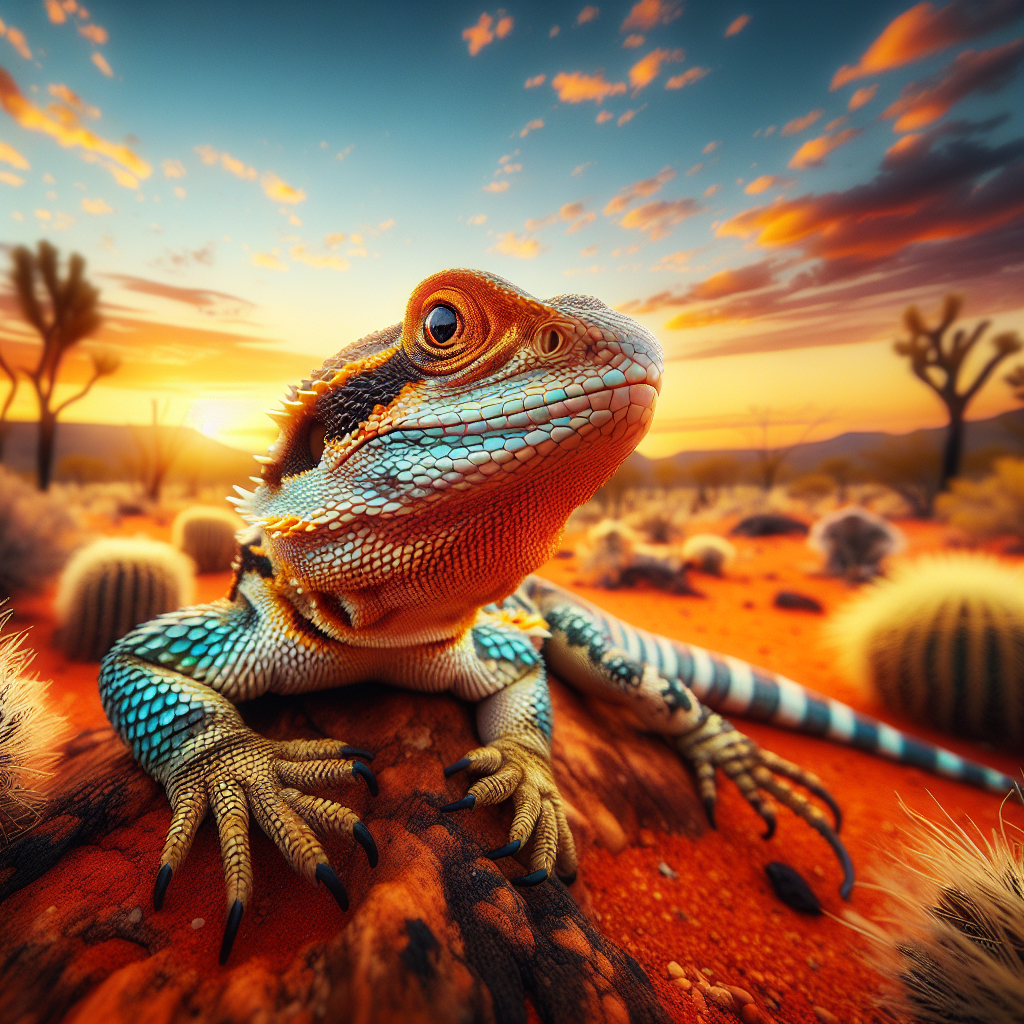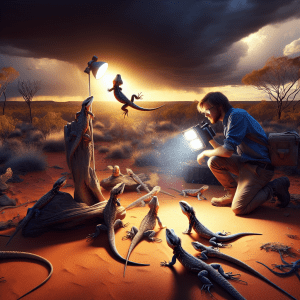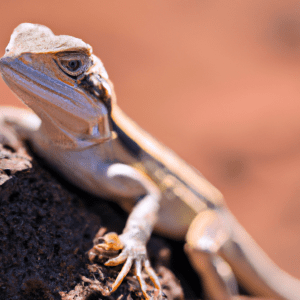Introduction: Understanding Outback Lizards and Their Environment
Have you ever marveled at the incredible adaptations of Outback lizards to survive in such harsh conditions? These fascinating creatures have evolved remarkable strategies to thrive in the challenging environment of the Australian Outback.
Imagine this – a tiny lizard basking in the scorching sun, seemingly unfazed by the blistering heat. It’s not just about sunbathing; it’s a survival tactic. These lizards have mastered the art of thermoregulation, using their environment to regulate their body temperature efficiently.
One of the most interesting aspects of Outback lizards is their behavioral adaptations. From seeking shade during the hottest hours to burrowing underground to escape extreme temperatures, these reptiles have a repertoire of behaviors that help them cope with the unforgiving climate.
But it’s not just about behavior; their physiology plays a crucial role too. Did you know that some Outback lizards can absorb water through their skin to stay hydrated in arid conditions? It’s a remarkable adaptation that highlights the ingenuity of these creatures.
As we delve deeper into the world of Outback lizards and their climate adaptations, we begin to appreciate the intricate web of life that exists in this harsh yet beautiful landscape. These reptiles are not just survivors; they are true masters of adaptation, showing us the incredible resilience of nature in the face of adversity.
Importance of Climate Adaptations in Outback Lizards
Climate adaptations are crucial for Outback lizards to thrive in their harsh environment. These adaptations are like superpowers that help these reptiles conquer the scorching heat and limited resources of the Outback.
Imagine yourself as an Outback lizard, basking in the relentless sun, and you start to feel a bit thirsty. These lizards have some pretty cool tricks up their sleeves to deal with such challenges.
One fascinating fact about Outback lizards is their ability to regulate their body temperature effectively. They can adjust their behavior and physiology to stay cool when it’s scorching hot outside.
Adaptations like changing their activity patterns, seeking shade, and even altering their metabolism help Outback lizards survive in extreme conditions. It’s like having a built-in survival manual that kicks in when things get tough.
These amazing creatures have evolved over time to develop specialized features that make them true masters of adaptation. From their unique skin structures to their efficient water-saving mechanisms, Outback lizards are nature’s ultimate survivors.
Next time you spot an Outback lizard soaking up the sun, take a moment to appreciate the incredible adaptations that allow them to thrive in one of the harshest environments on Earth. They may be small in size, but their resilience is truly larger than life.
Behavioral Adaptations of Outback Lizards
When it comes to the behavioral adaptations of Outback lizards, it’s truly fascinating to observe how these reptiles have evolved to survive in such harsh environments. Imagine walking through the arid Outback and stumbling upon a lizard basking in the sun. You might notice how it quickly scurries away at the slightest sound, displaying its remarkable agility and speed. These behavioral traits are crucial for Outback lizards, allowing them to evade predators and seek shelter when needed. Additionally, did you know that some species of Outback lizards are known to change color based on their surroundings? This remarkable ability helps them blend in with their environment, offering them a clever camouflage strategy against potential threats. It’s like having a built-in disguise! Have you ever wondered how these lizards communicate with one another in such vast and often desolate landscapes? Their unique behaviors and interactions with one another tell a story of adaptation and survival that is both captivating and awe-inspiring. Next time you catch a glimpse of an Outback lizard darting across the red earth, take a moment to appreciate the intricate behavioral adaptations that allow these creatures to thrive in one of the harshest environments on Earth.
Physiological Adaptations for Surviving Extreme Conditions
In the realm of Outback lizards, their physiological adaptations hold the key to their survival. These remarkable creatures have evolved intricate mechanisms to withstand the harsh and unforgiving conditions of their environment. Imagine a lizard that can regulate its body temperature with precision, allowing it to thrive in scorching heat or freezing cold. It’s like having a built-in thermostat that adjusts to the ever-changing climate of the Outback.
One fascinating fact about the physiological adaptations of Outback lizards is their ability to go without water for extended periods. These resilient reptiles have developed specialized kidneys that efficiently extract and retain moisture from their food, enabling them to survive in arid conditions where water sources are scarce.
The challenge lies in the delicate balance of maintaining these physiological adaptations in the face of environmental changes and human encroachment. As the Outback landscape undergoes transformations due to climate change and human activities, the survival of these unique lizard species hangs in the balance.
Understanding the intricacies of their physiological adaptations not only sheds light on the remarkable resilience of Outback lizards but also highlights the interconnectedness of all living organisms with their environment. By appreciating the marvels of nature’s design, we can cultivate a deeper respect for the fragile ecosystems that sustain life on our planet.
Anatomical Features That Aid in Climate Adaptations
When it comes to the behavioral adaptations of Outback lizards, it’s like witnessing a masterclass in survival. These remarkable creatures have honed their behaviors over generations to thrive in one of the harshest environments on the planet.
Imagine this: an Outback lizard basking in the scorching sun, seemingly unfazed by the blistering heat. This nonchalant behavior isn’t just for show; it’s a strategic move to absorb warmth and regulate their body temperature efficiently.
Did you know that some Outback lizards exhibit a unique behavior called “shuttling”? This involves moving between shady and sunny spots throughout the day to maintain an optimal body temperature. It’s like watching a carefully choreographed dance unfold in the wilderness.
But it’s not all sunbathing and leisure for these lizards. They also showcase remarkable predator avoidance tactics, such as freezing in place to blend seamlessly into their surroundings or executing lightning-fast escapes when threatened.
So, next time you spot an Outback lizard darting across the red earth, take a moment to appreciate the intricate behaviors that have been fine-tuned through years of evolution. These adaptations aren’t just survival strategies; they’re a testament to the resilience and ingenuity of nature in the face of adversity.
Reproductive Strategies of Outback Lizards
Interactions Between Outback Lizards and their Environment
Have you ever stopped to marvel at the intricate dance between Outback lizards and their surroundings? These reptiles have perfected the art of blending in with the rugged terrain, almost becoming one with the landscape. It’s like a real-life game of hide-and-seek, where survival depends on being the ultimate master of disguise.
Every movement, every coloration, every behavior has a purpose in the world of Outback lizards. Take, for example, the Thorny Devil, with its spiky exterior that not only deters predators but also helps in absorbing water through capillary action. Nature truly is a master of innovation.
But amidst this harmonious relationship lies a delicate balance that can easily be disrupted. Human activities such as habitat destruction and climate change pose significant threats to the intricate web of interactions that sustain these fascinating creatures. As we continue to encroach upon their territories, we must ask ourselves: Are we willing to jeopardize this ancient dance for the sake of progress?
So, the next time you spot a camouflaged lizard basking in the sun or darting across the red sands of the Outback, pause for a moment and ponder the beauty of its adaptation. Perhaps we can learn a thing or two from these resilient creatures about coexisting with our environment in perfect harmony.
Interactions Between Outback Lizards and their Environment
In the intricate dance of nature, Outback lizards and their environment share a symbiotic relationship. These reptiles have evolved over time, adapting to the harsh climate conditions of the Australian Outback in remarkable ways. From the vibrant Thorny Devil to the elusive Shingleback, each species has its own unique interactions with the environment.
Imagine stumbling upon a majestic Perentie lizard basking in the sun, perfectly camouflaged among the red rocks. These moments remind us of the delicate balance between survival and adaptation.
The Outback environment presents challenges that push lizards to innovate. How do these creatures navigate the scorching heat and limited resources? Their ability to find shelter, regulate body temperature, and conserve water showcases the marvels of evolution.
As we delve deeper into the world of Outback lizards, we uncover a tapestry of resilience and ingenuity. The intricate web of predator-prey dynamics, competition for resources, and territorial behaviors paints a vivid picture of survival in the wild.
By understanding these interactions, we gain insights into the fragile yet robust ecosystem of the Outback. How can we, as stewards of the environment, ensure the continued harmony between Outback lizards and their habitat? Let’s embark on a journey of discovery and conservation, celebrating the wonders of nature’s intricate design.
Threats to Climate Adaptations in Outback Lizards
Imagine this: Outback lizards, masters of adaptation, facing a new challenge – a changing climate.
These resilient creatures have evolved over centuries to survive in the harsh Outback environment.
However, with climate change threatening their habitats, their remarkable adaptations are put to the test.
One fascinating aspect is how Outback lizards adjust their behaviors in response to environmental shifts.
For instance, some species may alter their foraging patterns or basking behaviors to cope with changing temperatures.
Despite their incredible resilience, Outback lizards face increasing pressures from habitat loss and human activities.
Conservation efforts are crucial to protect these unique reptiles and ensure their survival in the face of these challenges.
As we delve deeper into understanding Outback lizards’ adaptations and struggles, it prompts us to reflect on our impact on the environment.
How can we, as stewards of the planet, support conservation initiatives to safeguard the future of these remarkable creatures?
By appreciating the significance of Outback lizards’ adaptations, we gain a greater appreciation for the interconnectedness of all living beings on Earth.
Conservation Efforts to Protect Outback Lizards
Conservation efforts to protect Outback lizards are crucial in ensuring their survival in the ever-changing environment. These reptiles have evolved remarkable adaptations to thrive in the harsh Outback conditions, but they face numerous threats that put their existence at risk.
One of the main challenges in conserving Outback lizards is the impact of habitat destruction caused by human activities. As their natural habitats diminish, these resilient creatures are forced to adapt to new environments, which may not always be suitable for their survival.
To address this issue, researchers and conservationists are working tirelessly to establish protected areas and implement habitat restoration initiatives to safeguard the habitats of Outback lizards. By creating safe havens for these unique reptiles, we can help ensure that future generations will continue to marvel at their incredible adaptations and resilience.
Considering the broader implications of conserving Outback lizards, it is not just about preserving a single species but protecting the delicate balance of the entire ecosystem. These lizards play a vital role in their environment as both predators and prey, contributing to the overall biodiversity of the Outback.
As we strive to protect Outback lizards, we are also safeguarding the intricate web of life that sustains the Outback ecosystem. By valuing and preserving these fascinating creatures, we are investing in the health and resilience of the Outback for generations to come.
Conclusion: Appreciating the Resilience of Outback Lizards
Have you ever wondered how Outback lizards manage to survive in such extreme climates? These remarkable creatures have evolved incredible adaptations to thrive in the harsh conditions of the Australian Outback.
Imagine being a tiny lizard trying to navigate scorching heat and limited water sources every day. It’s a tough life out there, but Outback lizards have some tricks up their sleeves to make it work.
One fascinating aspect of Outback lizards is their behavioral adaptations. These creatures have learned to regulate their body temperature by basking in the sun or seeking shade when it gets too hot.
Their physiological adaptations are equally impressive. Outback lizards can go for long periods without water by efficiently conserving moisture in their bodies.
Anatomically, these lizards have unique features that help them survive in the harsh environment. From specialized skin structures to modified scales, every aspect of their anatomy plays a role in their survival.
Now, here’s a thought-provoking question for you: How do you think Outback lizards’ adaptations compare to those of other desert-dwelling animals?
As we delve deeper into the world of Outback lizards, we’ll uncover the intricate ways in which these creatures have adapted to their challenging environment. Stay tuned for more fascinating insights into the lives of these resilient reptiles.




